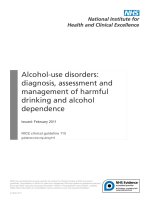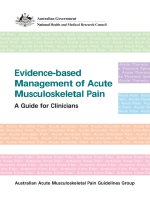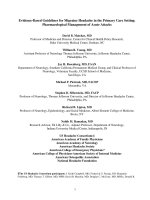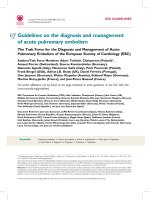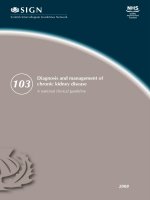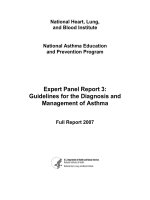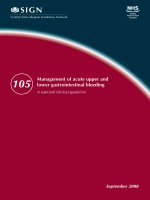Diagnosis and initial management of acute stroke and transient ischaemic attack (TIA) ppt
Bạn đang xem bản rút gọn của tài liệu. Xem và tải ngay bản đầy đủ của tài liệu tại đây (295.11 KB, 37 trang )
Issue date: July 2008
NICE clinical guideline 68
Developed by the National Collaborating Centre for Chronic Conditions
Stroke
Diagnosis and initial management of
acute stroke and transient ischaemic
attack (TIA)
NICE clinical guideline 68
Stroke: diagnosis and initial management of acute stroke and transient
ischaemic attack (TIA)
Ordering information
You can download the following documents from www.nice.org.uk/CG068
• The NICE guideline (this document) – all the recommendations.
• A quick reference guide – a summary of the recommendations for
healthcare professionals.
• ‘Understanding NICE guidance’ – information for patients and carers.
• The full guideline – all the recommendations, details of how they were
developed, and reviews of the evidence they were based on.
For printed copies of the quick reference guide or ‘Understanding NICE
guidance’, phone NICE publications on 0845 003 7783 or email
and quote:
• N1621 (quick reference guide)
• N1622 (‘Understanding NICE guidance’).
NICE clinical guidelines are recommendations about the treatment and care of
people with specific diseases and conditions in the NHS in England and
Wales
This guidance represents the view of the Institute, which was arrived at after
careful consideration of the evidence available. Healthcare professionals are
expected to take it fully into account when exercising their clinical judgement.
However, the guidance does not override the individual responsibility of
healthcare professionals to make decisions appropriate to the circumstances
of the individual patient, in consultation with the patient and/or guardian or
carer and informed by the summary of product characteristics of any drugs
they are considering.
Implementation of this guidance is the responsibility of local commissioners
and/or providers. Commissioners and providers are reminded that it is their
responsibility to implement the guidance, in their local context, in light of their
duties to avoid unlawful discrimination and to have regard to promoting
equality of opportunity. Nothing in this guidance should be interpreted in a way
that would be inconsistent with compliance with those duties.
National Institute for Health and Clinical Excellence
MidCity Place
71 High Holborn
London WC1V 6NA
www.nice.org.uk
© National Institute for Health and Clinical Excellence, 2008. All rights reserved. This material
may be freely reproduced for educational and not-for-profit purposes. No reproduction by or
for commercial organisations, or for commercial purposes, is allowed without the express
written permission of the Institute.
Contents
Introduction 4
Patient-centred care 7
Key priorities for implementation 8
1 Guidance 10
1.1 Rapid recognition of symptoms and diagnosis 10
1.2 Imaging in people who have had a suspected TIA or
non-disabling stroke 12
1.3 Specialist care for people with acute stroke 14
1.4 Pharmacological treatments for people with acute stroke 15
1.5 Maintenance or restoration of homeostasis 19
1.6 Nutrition and hydration 20
1.7 Early mobilisation and optimum positioning of people with
acute stroke 22
1.8 Avoidance of aspiration pneumonia 22
1.9 Surgery for people with acute stroke 23
2 Notes on the scope of the guidance 24
3 Implementation 26
4 Research recommendations 26
5 Other versions of this guideline 29
6 Related NICE guidance 30
7 Updating the guideline 31
Appendix A: The Guideline Development Group 32
Appendix B: The Guideline Review Panel 35
Appendix C: The algorithms 36
Appendix D: Glossary of tools and criteria 37
Introduction
Stroke is a preventable and treatable disease. Over the past two decades a
growing body of evidence has overturned the traditional perception that stroke
is simply a consequence of aging that inevitably results in death or severe
disability. Evidence is accumulating for more effective primary and secondary
prevention strategies, better recognition of people at highest risk, and
interventions that are effective soon after the onset of symptoms.
Understanding of the care processes that contribute to a better outcome has
improved, and there is now good evidence to support interventions and care
processes in stroke rehabilitation.
In the UK, the National Sentinel Stroke Audits have documented changes in
secondary care provision over the last 10 years, with increasing numbers of
patients being treated in stroke units, more evidence-based practice, and
reductions in mortality and length of hospital stay. In order for evidence from
research studies to improve outcomes for patients, it needs to be put into
practice. National guidelines provide clinicians, managers and service users
with summaries of evidence and recommendations for clinical practice.
Implementation of guidelines in practice, supported by regular audit, improves
the processes of care and clinical outcome.
This guideline covers interventions in the acute stage of a stroke (‘acute
stroke’) or transient ischaemic attack (TIA). Most of the evidence considered
relates to interventions in the first 48 hours after onset of symptoms, although
some interventions up to 2 weeks are covered. The Intercollegiate Stroke
Working Party (ICSWP) National Clinical Guidelines for Stroke (published July
2008), which is an update of the 2004 edition, includes all of the
recommendations from this NICE guideline.
This NICE guideline should also be read alongside the Department of Health
National Stroke Strategy
1
. There are some differences between the
recommendations made in the NICE guideline and those in the National
Stroke Strategy. However, the NICE Guideline Development Group (GDG)
1
Department of Health (2007) National Stroke Strategy. London: Department of Health.
NICE clinical guideline 68 – Stroke 4
feel that their recommendations are based on evidence derived from all of the
relevant literature as identified by systematic methodology.
Stroke has a sudden and sometimes dramatic impact on the patient and their
family, who need continuing information and support. Clinicians dealing with
acute care need to be mindful of the rehabilitation and secondary care needs
of people with stroke to ensure a smooth transition across the different phases
of care. In addition, it should be borne in mind that some recommendations in
the guideline may not be appropriate for patients who are dying or who have
severe comorbidities.
Incidence and prevalence
Stroke is a major health problem in the UK. It accounted for over 56,000
deaths in England and Wales in 1999, which represents 11% of all deaths
2
.
Most people survive a first stroke, but often have significant morbidity. Each
year in England, approximately 110,000 people have a first or recurrent stroke
and a further 20,000 people have a TIA. More than 900,000 people in England
are living with the effects of stroke, with half of these being dependent on
other people for help with everyday activities
3
.
Health and resource burden
In England, stroke is estimated to cost the economy around £7 billion per
year. This comprises direct costs to the NHS of £2.8 billion, costs of informal
care of £2.4 billion and costs because of lost productivity and disability of
£1.8 billion
2
. Until recently, stroke was not perceived as a high priority within
the NHS. However, a National Stroke Strategy was developed by the
Department of Health in 2007. This outlines an ambition for the diagnosis,
treatment and management of stroke, including all aspects of care from
emergency response to life after stroke.
2
Mant J, Wade DT, Winner S (2004) Health care needs assessment: stroke. In: Stevens A,
Raftery J, Mant J et al., editors, Health care needs assessment: the epidemiologically based
needs assessment reviews, First series, 2nd edition. Oxford: Radcliffe Medical Press, p141–
244.
3
National Audit Office (2005) Reducing brain damage: faster access to better stroke care.
(HC 452 Session 2005–2006). London: The Stationery Office.
NICE clinical guideline 68 – Stroke 5
Drugs
The guideline assumes that prescribers will use a drug’s summary of product
characteristics to inform their decisions for individual patients.
Definitions
Symptoms of stroke include numbness, weakness or paralysis, slurred
speech, blurred vision, confusion and severe headache. Stroke is defined by
the World Health Organization
4
as a clinical syndrome consisting of ‘rapidly
developing clinical signs of focal (at times global) disturbance of cerebral
function, lasting more than 24 h or leading to death with no apparent cause
other than that of vascular origin’. A transient ischaemic attack (TIA) is defined
as stroke symptoms and signs that resolve within 24 hours. However, there
are limitations to these definitions. For example, they do not include retinal
symptoms (sudden onset of monocular visual loss), which should be
considered as part of the definition of stroke and TIA. The symptoms of a TIA
usually resolve within minutes or a few hours at most, and anyone with
continuing neurological signs when first assessed should be assumed to have
had a stroke. The term ‘brain attack’ is sometimes used to describe any
neurovascular event and may be a clearer and less ambiguous term to use. A
non-disabling stroke is defined as a stroke with symptoms that last for more
than 24 hours but later resolve, leaving no permanent disability.
4
Hatano S (1976) Experience from a multicentre stroke register: a preliminary report. Bulletin
of the World Health Organization 54: 541–53.
NICE clinical guideline 68 – Stroke 6
Patient-centred care
This guideline offers best practice advice on the care of adults with acute
stroke or TIA.
Treatment and care should take into account peoples’ needs and preferences.
People with acute stroke or TIA should have the opportunity where possible to
make informed decisions about their care and treatment, in partnership with
their healthcare professionals. However, the person’s consent may be difficult
to obtain at the time of an acute episode, or where the stroke or TIA results in
communication problems. If the person does not have the capacity to make
decisions, healthcare professionals should follow the Department of Health
guidelines – ‘Reference guide to consent for examination or treatment’ (2001)
(available from www.dh.gov.uk/consent). Healthcare professionals should also
follow a code of practice accompanying the Mental Capacity Act. A summary
is available from www.publicguardian.gov.uk, which also gives details about
lasting power of attorney and advance decisions about treatment.
Good communication between healthcare professionals and people with acute
stroke or TIA, as well as their families and carers, is essential. It should be
supported by evidence-based written information tailored to the person’s
needs. Treatment and care, and the information people are given about it,
should be culturally appropriate. It should also be accessible to people with
dysphasia or additional needs such as physical, sensory or learning
disabilities, and to people who do not speak or read English.
Where appropriate, families and carers should have the opportunity to be
involved in decisions about treatment and care.
Families and carers should also be given the information and support they
need.
NICE clinical guideline 68 – Stroke 7
Key priorities for implementation
Rapid recognition of symptoms and diagnosis
• In people with sudden onset of neurological symptoms a validated tool,
such as FAST (Face Arm Speech Test), should be used outside hospital to
screen for a diagnosis of stroke or TIA. (1.1.1.1)
• People who have had a suspected TIA who are at high risk of stroke (that
is, with an ABCD
2
score of 4 or above) should have:
− aspirin (300 mg daily) started immediately
− specialist assessment
5
and investigation within 24 hours of onset of
symptoms
− measures for secondary prevention introduced as soon as the diagnosis
is confirmed, including discussion of individual risk factors. (1.1.2.2)
• People with crescendo TIA (two or more TIAs in a week) should be treated
as being at high risk of stroke, even though they may have an ABCD
2
score
of 3 or below. (1.1.2.3)
Specialist care for people with acute stroke
• All people with suspected stroke should be admitted directly to a specialist
acute stroke unit
6
following initial assessment, either from the community or
from the A&E department. (1.3.1.1)
• Brain imaging should be performed immediately
7
for people with acute
stroke if any of the following apply:
− indications for thrombolysis or early anticoagulation treatment
− on anticoagulant treatment
− a known bleeding tendency
− a depressed level of consciousness (Glasgow Coma Score below 13)
− unexplained progressive or fluctuating symptoms
5
Specialist assessment includes exclusion of stroke mimics, identification of vascular
treatment, identification of likely causes, and appropriate investigation and treatment.
6
An acute stroke unit is a discrete area in the hospital that is staffed by a specialist stroke
multidisciplinary team. It has access to equipment for monitoring and rehabilitating patients.
Regular multidisciplinary team meetings occur for goal setting.
7
The GDG felt that ‘immediately’ is defined as ‘ideally the next slot and definitely within
1 hour, whichever is sooner’, in line with the National Stroke Strategy.
NICE clinical guideline 68 – Stroke 8
− papilloedema, neck stiffness or fever
− severe headache at onset of stroke symptoms. (1.3.2.1)
Nutrition and hydration
• On admission, people with acute stroke should have their swallowing
screened by an appropriately trained healthcare professional before being
given any oral food, fluid or medication. (1.6.1.1)
NICE clinical guideline 68 – Stroke 9
1 Guidance
The following guidance is based on the best available evidence. The full
guideline (www.nice.org.uk/CG068fullguideline) gives details of the methods
and the evidence used to develop the guidance.
1.1 Rapid recognition of symptoms and diagnosis
There is evidence that rapid treatment improves outcome after stroke or TIA.
The recommendations in this section cover the rapid diagnosis of people who
have had sudden onset of symptoms that are indicative of stroke and TIA.
How to identify risk of subsequent stroke in people who have had a TIA is also
covered.
1.1.1 Prompt recognition of symptoms of stroke and TIA
1.1.1.1 In people with sudden onset of neurological symptoms a validated
tool, such as FAST (Face Arm Speech Test), should be used
outside hospital to screen for a diagnosis of stroke or TIA.
1.1.1.2 In people with sudden onset of neurological symptoms,
hypoglycaemia should be excluded as the cause of these
symptoms.
1.1.1.3 People who are admitted to accident and emergency (A&E) with a
suspected stroke or TIA should have the diagnosis established
rapidly using a validated tool, such as ROSIER (Recognition of
Stroke in the Emergency Room).
1.1.2 Assessment of people who have had a suspected TIA,
and identifying those at high risk of stroke
1.1.2.1 People who have had a suspected TIA (that is, they have no
neurological symptoms at the time of assessment [within 24 hours])
should be assessed as soon as possible for their risk of
NICE clinical guideline 68 – Stroke 10
subsequent stroke using a validated scoring system
8
, such as
ABCD
2
.
1.1.2.2 People who have had a suspected TIA who are at high risk of
stroke (that is, with an ABCD
2
score of 4 or above) should have:
• aspirin (300 mg daily) started immediately
• specialist assessment
9
and investigation within 24 hours of
onset of symptoms
• measures for secondary prevention introduced as soon as the
diagnosis is confirmed, including discussion of individual risk
factors.
1.1.2.3 People with crescendo TIA (two or more TIAs in a week) should be
treated as being at high risk of stroke, even though they may have
an ABCD
2
score of 3 or below.
1.1.2.4 People who have had a suspected TIA who are at lower risk of
stroke (that is, an ABCD
2
score of 3 or below) should have:
• aspirin (300 mg daily) started immediately
• specialist assessment
9
and investigation as soon as possible,
but definitely within 1 week of onset of symptoms
• measures for secondary prevention introduced as soon as the
diagnosis is confirmed, including discussion of individual risk
factors.
1.1.2.5 People who have had a TIA but who present late (more than
1 week after their last symptom has resolved) should be treated as
though they are at lower risk of stroke.
8
These scoring systems exclude certain populations that may be at particularly high risk of
stroke, such as those with recurrent TIAs and those on anticoagulation treatment, who also
need urgent evaluation. They also may not be relevant to patients who present late.
9
Specialist assessment includes exclusion of stroke mimics, identification of vascular
treatment, identification of likely causes, and appropriate investigation and treatment.
NICE clinical guideline 68 – Stroke 11
1.2 Imaging in people who have had a suspected TIA or
non-disabling stroke
While all people with symptoms of acute stroke need urgent brain scanning,
there is less evidence to recommend brain scanning in those people whose
symptoms have completely resolved by the time of assessment. This section
contains recommendations about which people with suspected TIA need brain
imaging and the type of imaging that is most helpful.
Some people who have had a stroke or TIA have narrowing of the carotid
artery that may require surgical intervention. Carotid imaging is required to
define the extent of carotid artery narrowing. Sections 1.2.3 and 1.2.4 cover
the optimum timing of carotid imaging, and the selection of appropriate
patients for, and timing of, carotid endarterectomy. The use of carotid stenting
was also reviewed by the GDG. However, no evidence for early carotid
stenting was found on which the GDG felt they could base a recommendation.
For more information, see chapter 6 of the full guideline.
1.2.1 Suspected TIA – referral for urgent brain imaging
1.2.1.1 People who have had a suspected TIA (that is, whose symptoms
and signs have completely resolved within 24 hours) should be
assessed by a specialist (within 1 week of symptom onset) before a
decision on brain imaging is made.
1.2.1.2 People who have had a suspected TIA who are at high risk of
stroke (for example, an ABCD
2
score of 4 or above, or with
crescendo TIA) in whom the vascular territory or pathology is
uncertain
10
should undergo urgent brain imaging
11
(preferably
diffusion-weighted MRI [magnetic resonance imaging]).
10
Examples where brain imaging is helpful in the management of TIA are:
• people being considered for carotid endarterectomy where it is uncertain whether the
stroke is in the anterior or posterior circulation
• people with TIA where haemorrhage needs to be excluded, for example long duration
of symptoms or people on anticoagulants
• where an alternative diagnosis (for example migraine, epilepsy or tumour) is being
considered.
NICE clinical guideline 68 – Stroke 12
1.2.1.3 People who have had a suspected TIA who are at lower risk of
stroke (for example, an ABCD
2
score of less than 4) in whom the
vascular territory or pathology is uncertain
10
should undergo brain
imaging
12
(preferably diffusion-weighted MRI).
1.2.2 Type of brain imaging for people with suspected TIA
1.2.2.1 People who have had a suspected TIA who need brain imaging
(that is, those in whom vascular territory or pathology is uncertain)
should undergo diffusion-weighted MRI except where
contraindicated
13
, in which case CT (computed tomography)
scanning should be used.
1.2.3 Early carotid imaging in people with acute non-disabling
stroke or TIA
1.2.3.1 All people with suspected non-disabling stroke or TIA who after
specialist assessment are considered as candidates for carotid
endarterectomy should have carotid imaging within 1 week of onset
of symptoms. People who present more than 1 week after their last
symptom of TIA has resolved should be managed using the lower-
risk pathway.
1.2.4 Urgent carotid endarterectomy and carotid stenting
1.2.4.1 People with stable neurological symptoms from acute non-disabling
stroke or TIA who have symptomatic carotid stenosis of 50–99%
according to the NASCET (North American Symptomatic Carotid
Endarterectomy Trial) criteria, or 70–99% according to the ECST
(European Carotid Surgery Trialists’ Collaborative Group) criteria,
should:
11
The GDG felt that urgent brain imaging is defined as imaging that takes place ‘within
24 hours of onset of symptoms’. This is in line with the National Stroke Strategy.
12
The GDG felt that brain imaging in people with a lower risk of stroke should take place
‘within 1 week of onset of symptoms’. This is in line with the National Stroke Strategy.
13
Contraindications to MRI include people who have any of the following: a pacemaker,
shrapnel, some brain aneurysm clips and heart valves, metal fragments in eyes, severe
claustrophobia.
NICE clinical guideline 68 – Stroke 13
• be assessed and referred for carotid endarterectomy within
1 week of onset of stroke or TIA symptoms
• undergo surgery within a maximum of 2 weeks of onset of stroke
or TIA symptoms
• receive best medical treatment (control of blood pressure,
antiplatelet agents, cholesterol lowering through diet and drugs,
lifestyle advice).
1.2.4.2 People with stable neurological symptoms from acute non-disabling
stroke or TIA who have symptomatic carotid stenosis of less than
50% according to the NASCET criteria, or less than 70% according
to the ECST criteria, should:
• not undergo surgery
• receive best medical treatment (control of blood pressure,
antiplatelet agents, cholesterol lowering through diet and drugs,
lifestyle advice).
1.2.4.3 Carotid imaging reports should clearly state which criteria (ECST or
NASCET) were used when measuring the extent of carotid
stenosis.
1.3 Specialist care for people with acute stroke
This section provides recommendations about the optimum care for people
with acute stroke: where they should be cared for and how soon they should
undergo brain imaging.
1.3.1 Specialist stroke units
1.3.1.1 All people with suspected stroke should be admitted directly to a
specialist acute stroke unit
14
following initial assessment, either
from the community or from the A&E department.
14
An acute stroke unit is a discrete area in the hospital that is staffed by a specialist stroke
multidisciplinary team. It has access to equipment for monitoring and rehabilitating patients.
Regular multidisciplinary team meetings occur for goal setting.
NICE clinical guideline 68 – Stroke 14
1.3.2 Brain imaging for the early assessment of people with
acute stroke
1.3.2.1 Brain imaging should be performed immediately
15
for people with
acute stroke if any of the following apply:
• indications for thrombolysis or early anticoagulation treatment
• on anticoagulant treatment
• a known bleeding tendency
• a depressed level of consciousness (Glasgow Coma Score
below 13)
• unexplained progressive or fluctuating symptoms
• papilloedema, neck stiffness or fever
• severe headache at onset of stroke symptoms.
1.3.2.2 For all people with acute stroke without indications for immediate
brain imaging, scanning should be performed as soon as
possible
16
.
1.4 Pharmacological treatments for people with acute
stroke
Urgent treatment has been shown to improve outcome in stroke. This section
contains recommendations about urgent pharmacological treatment in people
with acute stroke.
1.4.1 Thrombolysis with alteplase
1.4.1.1 Alteplase is recommended for the treatment of acute ischaemic
stroke when used by physicians trained and experienced in the
management of acute stroke. It should only be administered in
15
The GDG felt that ‘immediately’ is defined as ‘ideally the next slot and definitely within
1 hour, whichever is sooner’, in line with the National Stroke Strategy.
16
The GDG felt that ‘as soon as possible’ is defined as ’within a maximum of 24 hours after
onset of symptoms’.
NICE clinical guideline 68 – Stroke 15
centres with facilities that enable it to be used in full accordance
with its marketing authorisation
17
.
1.4.1.2 Alteplase should be administered only within a well organised
stroke service with:
• staff trained in delivering thrombolysis and in monitoring for any
complications associated with thrombolysis
• level 1 and level 2 nursing care staff trained in acute stroke and
thrombolysis
18
• immediate access to imaging and re-imaging, and staff trained to
interpret the images.
1.4.1.3 Staff in A&E departments, if appropriately trained and supported,
can administer alteplase
19
for the treatment of acute ischaemic
stroke provided that patients can be managed within an acute
stroke service with appropriate neuroradiological and stroke
physician support.
1.4.1.4 Protocols should be in place for the delivery and management of
thrombolysis, including post-thrombolysis complications.
1.4.2 Aspirin and anticoagulant treatment
People with acute ischaemic stroke
1.4.2.1 All people presenting with acute stroke who have had a diagnosis
of primary intracerebral haemorrhage excluded by brain imaging
should, as soon as possible but certainly within 24 hours, be given:
• aspirin 300 mg orally if they are not dysphagic or
• aspirin 300 mg rectally or by enteral tube if they are dysphagic.
17
This recommendation is from ‘Alteplase for the treatment of acute ischaemic stroke’ (NICE
technology appraisal guidance 122).
18
See NHS Data Dictionary, ‘Critical care level’ [online]. Available from:
www.datadictionary.nhs.uk/data_dictionary/attributes/c/cou/critical_care_level_de.asp?shown
av=1
19
In accordance with its marketing authorisation.
NICE clinical guideline 68 – Stroke 16
Thereafter, aspirin 300 mg should be continued until 2 weeks after
the onset of stroke symptoms, at which time definitive long-term
antithrombotic treatment should be initiated. People being
discharged before 2 weeks can be started on long-term treatment
earlier.
1.4.2.2 Any person with acute ischaemic stroke for whom previous
dyspepsia associated with aspirin is reported should be given a
proton pump inhibitor in addition to aspirin.
1.4.2.3 Any person with acute ischaemic stroke who is allergic to or
genuinely intolerant of aspirin
20
should be given an alternative
antiplatelet agent.
1.4.2.4 Anticoagulation treatment should not be used routinely
21
for the
treatment of acute stroke.
People with acute venous stroke
1.4.2.5 People diagnosed with cerebral venous sinus thrombosis (including
those with secondary cerebral haemorrhage) should be given full-
dose anticoagulation treatment (initially full-dose heparin and then
warfarin [INR 2–3]) unless there are comorbidities that preclude its
use.
People with stroke associated with arterial dissection
1.4.2.6 People with stroke secondary to acute arterial dissection should be
treated with either anticoagulants or antiplatelet agents, preferably
20
Aspirin intolerance is defined in NICE technology appraisal guidance 90 (‘Clopidogrel and
modified-release dipyridamole in the prevention of occlusive vascular events’; see
www.nice/org.uk/TA090) as either of the following:
• proven hypersensitivity to aspirin-containing medicines
• history of severe dyspepsia induced by low-dose aspirin.
21
There may be a subgroup of people for whom the risk of venous thromboembolism
outweighs the risk of haemorrhagic transformation. People considered to be at particularly
high risk of venous thromboembolism include anyone with complete paralysis of the leg, a
previous history of venous thromboembolism, dehydration or comorbidities (such as
malignant disease), or who is a current or recent smoker. Such people should be kept under
regular review if they are given prophylactic anticoagulation. Further details will be included in
the forthcoming NICE clinical guideline ‘
The prevention of venous thromboembolism in all
hospital patients’ (publication expected in September 2009)
.
NICE clinical guideline 68 – Stroke 17
as part of a randomised controlled trial to compare the effects of
the two treatments.
People with acute ischaemic stroke associated with antiphospholipid
syndrome
1.4.2.7 People with antiphospholipid syndrome who have an acute
ischaemic stroke should be managed in same way as people with
acute ischaemic stroke without antiphospholipid syndrome
22
.
Reversal of anticoagulation treatment in people with haemorrhagic
stroke
1.4.2.8 Clotting levels in people with a primary intracerebral haemorrhage
who were receiving anticoagulation treatment before their stroke
(and have elevated INR) should be returned to normal as soon as
possible, by reversing the effects of the anticoagulation treatment
using a combination of prothrombin complex concentrate and
intravenous vitamin K.
1.4.3 Anticoagulation treatment for other comorbidities
1.4.3.1 People with disabling ischaemic stroke who are in atrial fibrillation
should be treated with aspirin 300 mg for the first 2 weeks before
considering anticoagulation treatment.
1.4.3.2 In people with prosthetic valves who have disabling cerebral
infarction and who are at significant risk of haemorrhagic
transformation, anticoagulation treatment should be stopped for
1 week and aspirin 300 mg substituted.
1.4.3.3 People with ischaemic stroke and symptomatic proximal deep vein
thrombosis or pulmonary embolism should receive anticoagulation
treatment in preference to treatment with aspirin unless there are
other contraindications to anticoagulation.
22
There was insufficient evidence to support any recommendation on the safety and efficacy
of anticoagulants versus antiplatelets for the treatment of people with acute ischaemic stroke
associated with antiphospholipid syndrome.
NICE clinical guideline 68 – Stroke 18
1.4.3.4 People with haemorrhagic stroke and symptomatic deep vein
thrombosis or pulmonary embolism should have treatment to
prevent the development of further pulmonary emboli using either
anticoagulation or a caval filter.
1.4.4 Statin treatment
1.4.4.1 Immediate initiation of statin treatment is not recommended in
people with acute stroke
23
.
1.4.4.2 People with acute stroke who are already receiving statins should
continue their statin treatment.
1.5 Maintenance or restoration of homeostasis
A key element of care for people with acute stroke is the maintenance of
cerebral blood flow and oxygenation to prevent further brain damage after
stroke. This section contains recommendations on oxygen supplementation,
maintenance of normoglycaemia, and acute blood pressure manipulation.
1.5.1 Supplemental oxygen therapy
1.5.1.1 People who have had a stroke should receive supplemental oxygen
only if their oxygen saturation drops below 95%. The routine use of
supplemental oxygen is not recommended in people with acute
stroke who are not hypoxic.
1.5.2 Blood sugar control
1.5.2.1 People with acute stroke should be treated to maintain a blood
glucose concentration between 4 and 11 mmol/litre.
1.5.2.2 Optimal insulin therapy, which can be achieved by the use of
intravenous insulin and glucose, should be provided to all adults
with diabetes who have threatened or actual myocardial infarction
23
The consensus of the GDG is that it would be safe to start statins after 48 hours.
NICE clinical guideline 68 – Stroke 19
or stroke. Critical care and emergency departments should have a
protocol for such management
24
.
1.5.3 Blood pressure control
1.5.3.1 Anti-hypertensive treatment in people with acute stroke is
recommended only if there is a hypertensive emergency with one
or more of the following serious concomitant medical issues:
• hypertensive encephalopathy
• hypertensive nephropathy
• hypertensive cardiac failure/myocardial infarction
• aortic dissection
• pre-eclampsia/eclampsia
• intracerebral haemorrhage with systolic blood pressure over
200 mmHg.
1.5.3.2 Blood pressure reduction to 185/110 mmHg or lower should be
considered in people who are candidates for thrombolysis.
1.6 Nutrition and hydration
Many people with acute stroke are unable to swallow safely, and may require
supplemental hydration and nutrition. This section provides recommendations
on assessment of swallowing, hydration and nutrition.
1.6.1 Assessment of swallowing function
1.6.1.1 On admission, people with acute stroke should have their
swallowing screened by an appropriately trained healthcare
professional before being given any oral food, fluid or medication.
1.6.1.2 If the admission screen indicates problems with swallowing, the
person should have a specialist assessment of swallowing,
preferably within 24 hours of admission and not more than 72 hours
afterwards.
24
This recommendation is from ‘Type 1 diabetes: diagnosis and management of type 1
diabetes in children, young people and adults’ (NICE clinical guideline 15).
NICE clinical guideline 68 – Stroke 20
1.6.1.3 People with suspected aspiration on specialist assessment, or who
require tube feeding or dietary modification for 3 days, should be:
• re-assessed and considered for instrumental examination
• referred for dietary advice.
1.6.1.4 People with acute stroke who are unable to take adequate nutrition
and fluids orally should:
• receive tube feeding with a nasogastric tube within 24 hours of
admission
• be considered for a nasal bridle tube or gastrostomy if they are
unable to tolerate a nasogastric tube
• be referred to an appropriately trained healthcare professional
for detailed nutritional assessment, individualised advice and
monitoring.
1.6.2 Oral nutritional supplementation
1.6.2.1 All hospital inpatients on admission should be screened for
malnutrition and the risk of malnutrition. Screening should be
repeated weekly for inpatients
25
.
1.6.2.2 Screening should assess body mass index (BMI) and percentage
unintentional weight loss and should also consider the time over
which nutrient intake has been unintentionally reduced and/or the
likelihood of future impaired nutrient intake. The Malnutrition
Universal Screening Tool (MUST), for example, may be used to do
this
26
.
1.6.2.3 When screening for malnutrition and the risk of malnutrition,
healthcare professionals should be aware that dysphagia, poor oral
health and reduced ability to self-feed will affect nutrition in people
with stroke.
25
This recommendation is adapted from ‘Nutrition support in adults: oral nutrition support,
enteral tube feeding and parenteral nutrition’ (NICE clinical guideline 32).
26
This recommendation is from NICE clinical guideline 32.
NICE clinical guideline 68 – Stroke 21
1.6.2.4 Screening for malnutrition and the risk of malnutrition should be
carried out by healthcare professionals with appropriate skills and
training
26
.
1.6.2.5 Routine nutritional supplementation is not recommended for people
with acute stroke who are adequately nourished on admission.
1.6.2.6 Nutrition support should be initiated for people with stroke who are
at risk of malnutrition. This may include oral nutritional
supplements, specialist dietary advice and/or tube feeding.
1.6.2.7 All people with acute stroke should have their hydration assessed
on admission, reviewed regularly and managed so that normal
hydration is maintained.
1.7 Early mobilisation and optimum positioning of people
with acute stroke
Early mobilisation is considered a key element of acute stroke care. Sitting up
will help to maintain oxygen saturation and reduce the likelihood of hypostatic
pneumonia.
1.7.1.1 People with acute stroke should be mobilised as soon as possible
(when their clinical condition permits) as part of an active
management programme in a specialist stroke unit.
1.7.1.2 People with acute stroke should be helped to sit up as soon as
possible (when their clinical condition permits).
1.8 Avoidance of aspiration pneumonia
Aspiration pneumonia is a complication of stroke that is associated with
increased mortality and poor outcomes.
1.8.1.1 In people with dysphagia, food and fluids should be given in a form
that can be swallowed without aspiration, following specialist
assessment of swallowing.
NICE clinical guideline 68 – Stroke 22
1.9 Surgery for people with acute stroke
There is evidence that neurosurgical treatment may be indicated for a very
small number of carefully selected people with stroke. This section contains
recommendations for surgical intervention in people with intracerebral
haemorrhage or severe middle cerebral artery infarction.
1.9.1 Surgical referral for acute intracerebral haemorrhage
1.9.1.1 Stroke services should agree protocols for the monitoring, referral
and transfer of people to regional neurosurgical centres for the
management of symptomatic hydrocephalus.
1.9.1.2 People with intracranial haemorrhage should be monitored by
specialists in neurosurgical or stroke care for deterioration in
function and referred immediately for brain imaging when
necessary.
1.9.1.3 Previously fit people should be considered for surgical intervention
following primary intracranial haemorrhage if they have
hydrocephalus.
1.9.1.4 People with any of the following rarely require surgical intervention
and should receive medical treatment initially:
• small deep haemorrhages
• lobar haemorrhage without either hydrocephalus or rapid
neurological deterioration
• a large haemorrhage and significant comorbidities before the
stroke
• a score on the Glasgow Coma Scale of below 8 unless this is
because of hydrocephalus
• posterior fossa haemorrhage.
1.9.2 Surgical referral for decompressive hemicraniectomy
1.9.2.1 People with middle cerebral artery infarction who meet all of the
criteria below should be considered for decompressive
NICE clinical guideline 68 – Stroke 23
hemicraniectomy. They should be referred within 24 hours of onset
of symptoms and treated within a maximum of 48 hours.
• Aged 60 years or under.
• Clinical deficits suggestive of infarction in the territory of the
middle cerebral artery, with a score on the National Institutes of
Health Stroke Scale (NIHSS) of above 15.
• Decrease in the level of consciousness to give a score of 1 or
more on item 1a of the NIHSS.
• Signs on CT of an infarct of at least 50% of the middle cerebral
artery territory, with or without additional infarction in the territory
of the anterior or posterior cerebral artery on the same side, or
infarct volume greater than 145 cm
3
as shown on diffusion-
weighted MRI.
1.9.2.2 People who are referred for decompressive hemicraniectomy
should be monitored by appropriately trained professionals skilled
in neurological assessment.
2 Notes on the scope of the guidance
NICE guidelines are developed in accordance with a scope that defines what
the guideline will and will not cover. The scope of this guideline is available
from www.nice.org.uk/guidance/index.jsp?action=download&o=34392
Groups that are covered
• People with transient ischaemic attacks (TIAs) or completed strokes; that
is, an acute neurological event presumed to be vascular in origin and
causing cerebral ischaemia, cerebral infarction or cerebral haemorrhage.
This includes:
− first and recurrent events
− thrombotic and embolic events
− primary intracerebral haemorrhage of any cause, including venous
thrombosis.
NICE clinical guideline 68 – Stroke 24
Areas and groups that are not covered
• Specific issues relating to the general management of underlying
conditions are not considered, but immediate management to reduce the
extent of brain damage is included.
• People with subarachnoid haemorrhage.
• Children (aged 16 years and under).
How this guideline was developed
NICE commissioned the National Collaborating Centre for Chronic Conditions
to develop this guideline. The Centre established a Guideline Development
Group (see appendix A), which reviewed the evidence and developed the
recommendations. An independent Guideline Review Panel oversaw the
development of the guideline (see appendix B).
There is more information in the booklet: ‘The guideline development process:
an overview for stakeholders, the public and the NHS’ (third edition, published
April 2007), which is available from www.nice.org.uk/guidelinesprocess or
from NICE publications (phone 0845 003 7783 or email
and quote reference N1233).
NICE clinical guideline 68 – Stroke 25

